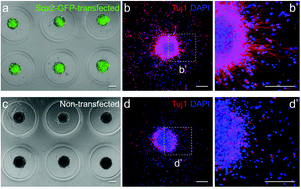Nanoparticle-mediated conversion of primary human astrocytes into neurons and oligodendrocytes†
Abstract
Central nervous system (CNS) diseases and injuries are accompanied by reactive gliosis and scarring involving the activation and proliferation of astrocytes to form hypertrophic and dense structures, which present a significant barrier to neural regeneration. Engineering astrocytes to functional neurons or oligodendrocytes may constitute a novel therapeutic strategy for CNS diseases and injuries. Such direct cellular programming has been successfully demonstrated using viral vectors via the transduction of transcriptional factors, such as Sox2, which could program resident astrocytes into neurons in the adult brain and spinal cord, albeit the efficiency was low. Here we report a non-viral nanoparticle-based transfection method to deliver Sox2 or Olig2 into primary human astrocytes and demonstrate the effective conversion of the astrocytes into neurons and oligodendrocyte progenitors following the transgene expression of Sox2 and Olig2, respectively. This approach is highly translatable for engineering astrocytes to repair injured CNS tissues.


 Please wait while we load your content...
Please wait while we load your content...